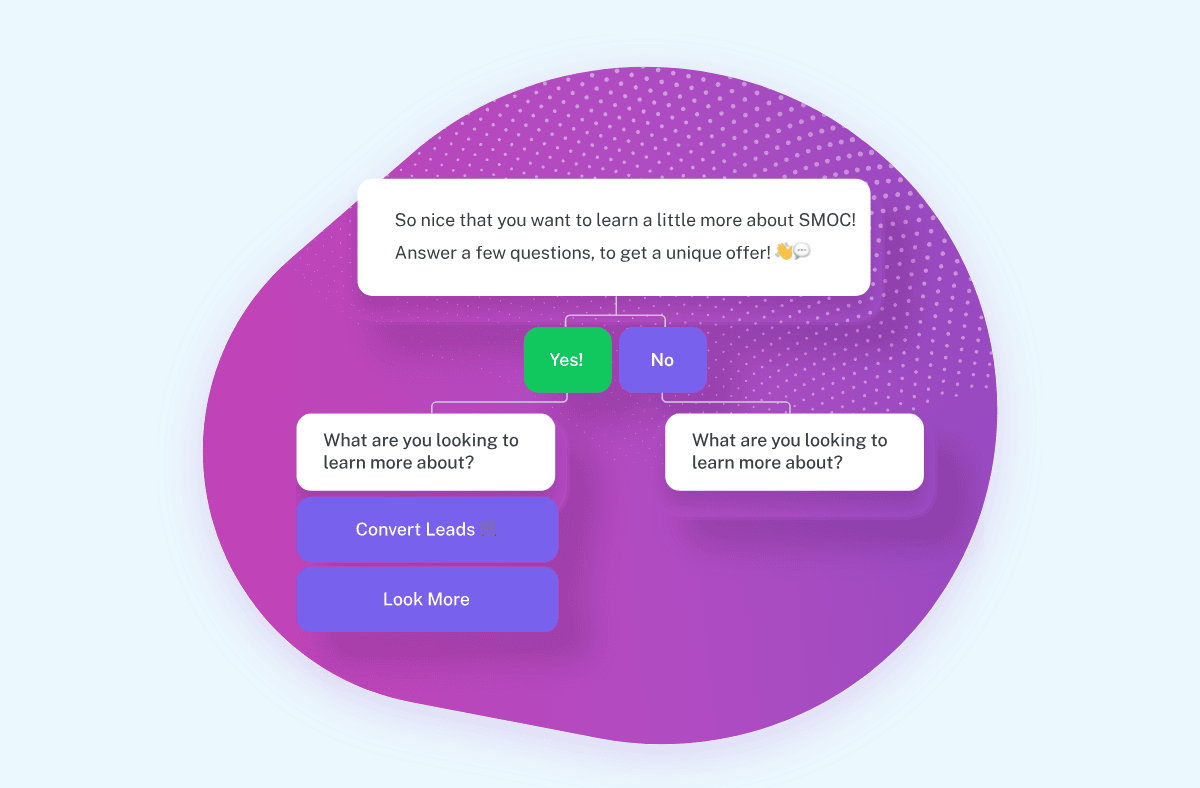The future of AI in sales: Insights from SMOC's CEO, Kristoffer Kvam
22 Jul 2024
We talked to Kristoffer Kvam, founder, and CEO at SMOC.AI, an AI-powered sales agent that increases conversion by personalizing and gamifying customer journeys. SMOC offers proactive AI sales agents, digital conversations, rewards, and data products that improve brand loyalty, customer insights, and conversions through engaging conversations and a custom-built recommendation engine. It enables businesses to reduce acquisition expenses while increasing client loyalty and capturing more data on existing and potential customers (post cookie). SMOCs vision is to let any brand simply plug the sales agent into any digital channel and give an automatic increase in sales and engagement.
Autentika: The headline on the SMOC website says: “Get your 24/7 proactive AI sales agent today.” Can you explain what AI agents are and how they function in sales?
Kristoffer Kvam: Sure. We can differentiate two main types of AI agents. First, there are chatbots, which interact with you by responding to your inputs—whether you type something in or speak to it. This is the type of AI agent that ChatGPT represents. These are typically used in customer service because they react to customer inquiries.
Then, there's the proactive agent, which operates based on a planned approach controlled by the company rather than the customer. This model suits sales because it involves initiating engagement and pushing information out to the customer rather than just reacting.
There's also a hybrid model that combines reactive and proactive elements. The reactive agent responds to customer input and problems, while a proactive agent has a clear plan to engage customers based on anticipated needs.
How do AI agents differ from the e-commerce solutions we already know? You mentioned their proactivity, but are there other significant differences?
There are several key differences. Traditional reactive modes, like chatbots based on FAQs, provide information based on what the user searches for. In contrast, a proactive AI agent often replaces current web technologies. Instead of using cookies to personalize content based on probabilistic data, a proactive agent personalizes interactions by directly engaging with the customer. It asks questions and provides tailored responses based on their answers.
The model for these interactions is conversational. Companies need to engage customers through conversation or ads through these channels. Traffic from these ads is highly valuable, and using state-of-the-art AI agents ensures high conversion rates. Static pages no longer suffice, and traditional SEO strategies might decline as people prefer platforms that provide direct answers rather than links. For example, many engineers now ask ChatGPT for solutions instead of visiting sites like Stack Overflow. This shift is causing traffic to these traditional sites to decrease, and user behavior is gradually changing to favor direct, conversational interactions, pushing technology and suppliers to follow suit.
You mentioned that AI agents, such as chatbots or virtual assistants, engage based on my answers and input. Do they gather any other data? Is there a limit to this personalization, or should we be concerned about how much a machine knows about us?
That's a great question. At least in our approach, every interaction and context element from the start of the conversation—like your browser type, time of day, and so on—are collected as attributes. Every interaction, including how fast you respond, your interests, and all your answers and questions, is stored in your profile. This method effectively collects first-party data while personalizing the experience.
For example, a customer sells alarm systems and uses our system on their website. The first question they ask is, "Do you have an alarm system today?" Yes or no? The journey for a customer who answers "yes" is completely different from one who answers "no." This simple question allows them to optimize their marketing and sales processes. It also helps them understand their traffic and customer needs more effectively.

The journey for a customer who answers "yes" is completely different from one who answers "no." (screen from SMOC)
Looking ahead, we're working on predicting additional customer attributes to personalize the experience further. For instance, if we predict that you're motivated by community, we might show you a picture of a group of people having fun together. On the other hand, if you prefer individual sports idols, we'd show you a picture of a sports star. This way, we connect with customers more meaningfully based on their predicted motivations.
What do you see as the next step, the next frontier in AI-driven personalization for sales?
It lies in refining how we personalize interactions in conversational modes. Currently, we present content that is relevant to the user. The next step for proactive agents is to present content that matches the user’s preferred style and context. For example, your interaction while working on your laptop during the day will differ from browsing personal items at night.
Understanding and adapting to these different contexts is crucial for effective sales. It's about connecting with the customer in a meaningful way. When we implement this level of personalization, we're already seeing significantly increased engagement and conversion rates. It's going to be fascinating to observe the long-term effects of these advancements.
Read also: Fact-checking in the age of AI: no longer just for newsrooms
Do you have any insights on end-user satisfaction from your customers? What kind of feedback have you received?
When we started the company, we focused on creating a mobile solution for Gen Zs, hence the name Smart Mobile Company (SMOC). We designed the front end based on their preferences, conducting field studies with around 400 people. One interesting insight was that trends popular with Gen Zs often reflected similar preferences in older generations. This surprised us, but it makes sense when you consider how quickly older generations adopt platforms like TikTok or Snapchat to connect with their grandchildren.
Moreover, we have specific rules for engaging customers, starting interactions, and challenging them effectively. Our team continuously tests and refines these approaches. These insights help us improve customer engagement and satisfaction across different demographics.
Read also: Automating the impossible: Jesse Lord on Fabriq
I'm curious about where things will go in the next five years. Do you think we'll reach a point where our AI assistants interact with AI agents and humans are relieved from buying processes?
We're already moving in that direction, and it highlights the difference between reactive and proactive models. A proactive agent can predict what you need and take action without waiting for your command. It’s similar to having a secretary or a butler who anticipates your needs and handles tasks for you, making your life more comfortable.
This proactive approach isn't just theoretical; it's happening. For example, you could develop a proactive AI to handle routine purchases or act as a personal coach, guiding you through decisions based on anticipated needs. This proactive behavior means AI isn't just responding to commands but is actively managing tasks on your behalf. So, yes, I believe we'll see more of this in the future where AI takes on a more autonomous and helpful role in our daily lives.
Do you observe any challenges or resistance with clients when implementing AI sales agents? What concerns do they typically have?
Yes, we often encounter resistance from conservative leaders or users who strongly believe in traditional methods like SEO. They see SEO as crucial and long-lasting, and while they are correct to some extent, adapting to new technologies is also essential—SEO is still relevant. Still, it's slowly evolving and may eventually become irrelevant.
Another challenge we often encounter is skepticism about whether our solutions will work in a specific domain. Clients say, "This won’t work in my country, my industry; we’re too conservative." However, we’ve found that people's core motivations remain consistent across different contexts, even if their behavior changes slightly.
For example, someone’s interest in group photos remains the same in their private and business life, although they might prefer more formal communication in business. The core personality is always there. This is the biggest mistake in personalization today—it's based on behavior and cookies, not core drivers.
Consider this: two users want to visit Spain and are searching for a holiday offer, but their motivations might vary significantly. One person might be motivated by sports events, while another prefers pool parties. Recognizing these differences is vital for effective marketing.
So, what would your advice be to potential customers still hesitating?
To be honest, most people I meet are very curious about what we're doing. Some are hesitant because they have clear priorities and are working on yearly plans. For instance, they might say, "This year, we're changing our CRM, so come back in three or four months." That's legitimate, but they often underestimate how easy it is to integrate new solutions. We can implement changes in parallel with their existing projects, often within a few days.
For example, I can create a quiz for your company in just two minutes. It’s quick and can be very engaging for your employees or customers. This isn't a big project; it can be easily adapted and improved over time.
Are there any minimal requirements your customers need to integrate or implement SMOC.AI? Could you briefly describe your process?
Once the client decides to proceed with our solution, the sales process typically identifies a specific case or a few cases they want to address. We start with a one-hour onboarding meeting with the client to document all the needs, requirements, goals, and targets.
Our success agents then generate different versions of these cases within a day. They might adapt them by adding images and other elements based on the targets and goals and the target personas the client wants to reach. It's important to understand the typical clients and brand priorities.
After that, the client reviews the cases, and we iterate based on their feedback. We aim to go live within a couple of days. The process is simple; you don’t need to integrate anything initially. For instance, you can place a link on your front page to go live with an agent. This opens a mock landing page branded as yours.
Once you capture leads, they can be sent directly to your mailbox. You can use the platform to integrate these leads into any CRM system, which typically takes 30 minutes.
Let’s sum up key points and core beliefs. What are three things you would like our readers to remember from this conversation?
Firstly, the evolution of SEO is coming, and we foresee significant changes in the way traditional content strategies must adapt. While articles and similar content remain valuable, we also emphasize creating guides and distributing them across modern platforms to stay ahead. Additionally, a notable shift in how search engines like Google prioritize results affects monetization strategies. Over 70% of queries now yield direct answers at the top of search results, challenging traditional SEO practices.
Another fundamental thing is the irreplaceable value of first-party data. In an era where data-driven insights are paramount, brands can sustainably differentiate themselves through customer data strategies. This approach contrasts with relying on third-party cookie data, which is increasingly unpopular and less reliable.
Lastly, we're focused on advancing personalization through interactive models and deeply understanding customer motivations. This approach underpins our product development and solutions, aiming to enhance customer engagement and satisfaction.

Kristoffer Kvam, founder, and CEO at SMOC



